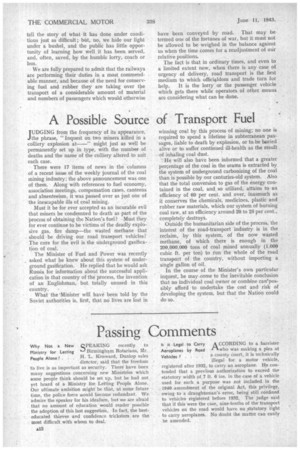A Possible Source of Transport Fuel
Page 14

If you've noticed an error in this article please click here to report it so we can fix it.
TUDGING from the frequency of its appearance, J the phrase, "Inquest on two miners killed in a colliery explosion at—" might just as well be permanently set up in type, with the number of deaths and the name of the colliery altered to suit each case.
There were 17 items of news in the columns of a recent issue of the weekly journal of the coal mining industry; the above announcement was one of them. Along with references to fuel economy, association meetings, compensation cases, canteens and absenteeism, it was passed over as just one of the inescapable ills of coal mining.
Must it be for ever accepted as an incurable evil that miners be condemned to death as part of the process of obtaining the Nation's fuel? Must they for ever continue to be victims of the deadly explosive gas, fire damp—the wasted methane that should be driving our road transport vehicles? The cure for the evil is the underground gasification of coal.
The Minister of Fuel and Power was recently asked what he knew about this system of underground gasification. He replied that he would ask Russia for information about the successful application in that country of the process, the invention of an Englishman, but totally unused in this country.
What the 'Minister will have been told by the Soviet authorities is, first, that no lives are lost in winning coal by this process of mining; no one is required to spend a lifetime in subterranean passages, liable to death by explosion, or to-be buried alive or to suffer continued ill-health as the result of inhaling coal dust.
He will also have been informed that a greater percentage of the coal in the seams is extracted by the system of underground carbonizing of the coal than is possible by our centuries-old system. Also that the total conversion to gas of the energy contained in the coal, and so utilized, attains to an efficiency of 60 per cent. and over, inasmuch as it conserves the chemicals, medicines, plastic and rubber raw materials, which our system of burning coal raw, at an efficiency around 20 to 25 per cent., completely destroys.
Outside the humanitarian side of the process, the interest of the road-transport industry is in the reclaim, by this system, of the now wasted methane, of which there is enough in the 200,000,000 tons of coal mined annually (1,000 cubic ft. per ton) to run the whole of the road transport of the country, without importing a single gallon of oil.
In the course of the Minister's own particular inquest, he may .come to the inevitable conclusion that no individual coal owner or combine can'possibly afford to undertake the cost and risk of developing the system, but that the Nation could do so.




















































